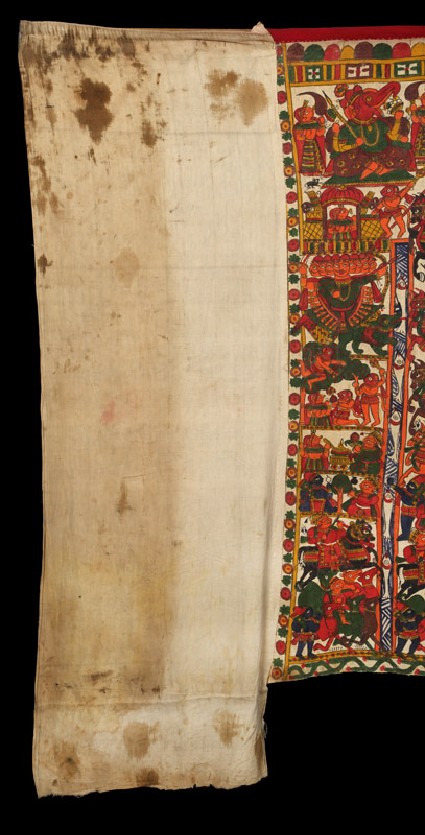Search Results: objects
Show search help- Reference URL
Actions
Pabuji's par, or narrative painting
-
Details
- Associated place
-
Asia › India › west India › Rajasthan (Bhilwara) (place of creation)
- Date
- 1983
- Artist/maker
-
Nandkishor Joshi (born 1954) (artist)
- Associated people
-
the bhopa Chotuji (active c. 1983) (commissioner)
- Material and technique
- gouache on cotton cloth
- Dimensions
- 151 x 567 cm (height x width)
- Material index
- Technique index
- Object type index
- No. of items
- 1
- Credit line
- Purchased, 1985.
- Accession no.
- EA1985.20
-
Further reading
Harle, J. C., and Andrew Topsfield, Indian Art in the Ashmolean Museum (Oxford: Ashmolean Museum, 1987), no. 81 on pp. 71-72, illus. p. 72
Topsfield, Andrew, ‘Rajasthani Painting: Its Study and Scope’, Andrew Topsfield, ed., Court Painting in Rajasthan (Mumbai: Marg Publications on behalf of the National Centre for the Performing Arts, 2000), p. 3, illus. p. 3 fig. 1
Location
-
- currently in research collection
Objects are sometimes moved to a different location. Our object location data is usually updated on a monthly basis. Contact the Jameel Study Centre if you are planning to visit the museum to see a particular object on display, or would like to arrange an appointment to see an object in our reserve collections.
Publications online
-

Indian Art in the Ashmolean Museum
This long cloth-painting (paṛ), profusely filled with narrative scenes according to a long established iconography, is in function a portable temple of the Rajasthani folk-god Pābūjī. Such paintings are carried from village to village by travelling folk-priests (bhopās), who unroll and erect them as a backdrop to their night-long recitations of the Pābūjī epic, with musical accompaniment usually provided by their wives.Such shows were familiar to Colonel Tod in the early 19th century, who writes in his Annals and antiquities of Rajasthan of “the itinerant bard and showman, who annually goes his round, exhibiting in pictorial delineations, while he recites in rhyme, the deeds of the warrior [Pābūjī] to the gossiping villagers of the desert”.
Very few of the paṛs which survive are of any great age; the earliest, in honour of another folk-god, Devnarāyaṇ, is dated 1867 A.D. The Museum’s example was painted by Nandkishor (born 1954), one of the younger artists at Bhulwara at the present day, who was trained by his father Dhanraj and his grandfather Kalyanmal, members of the Joshi clan of the Chipa caste (hereditarily associated with cloth-painting). Although brasher in colouring and more mechanical in line than the work of previous generations of artists, it is nonetheless a skillful and authentic example of the paṛ tradition.
© 2013 University of Oxford - Ashmolean Museum

